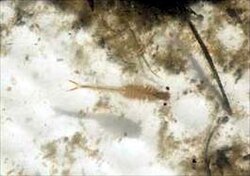| Streptocephalus woottoni | |
|---|---|
 | |
| Scientific classification | |
| Kingdom: | Animalia |
| Phylum: | Arthropoda |
| Class: | Branchiopoda |
| Order: | Anostraca |
| Family: | Streptocephalidae |
| Genus: | Streptocephalus |
| Species: | S. woottoni |
| Binomial name | |
| Streptocephalus woottoni Eng, Belk & Eriksen, 1990 | |
Streptocephalus woottoni, with the common name Riverside fairy shrimp, is a rare species of crustacean in the family Streptocephalidae. It is native to Southern California in the United States, and northern Baja California in northwest Mexico.

